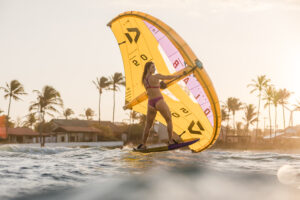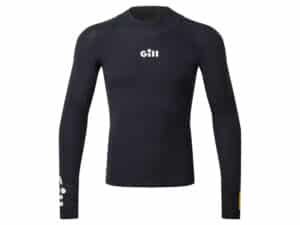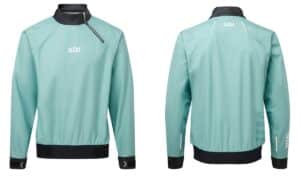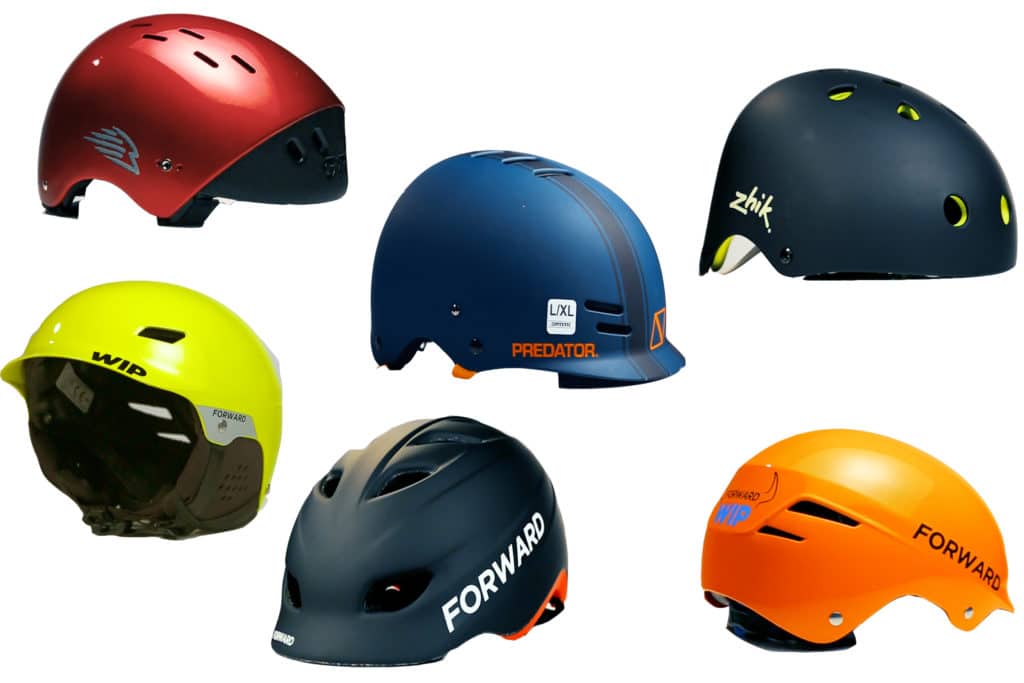
A few summers back, Lynne Shore, an Olympic gold medalist in the 470 at the 1988 games, was racing her Laser in breezy conditions off Hyannis, Massachusetts. She bore off around the weather mark and started surfing downwind. Close ahead, a fellow competitor who was sailing upwind abruptly tacked right in front of her. Fully planing, with no time or space to avoid a collision, Shore could do little but minimize the impact as best she could. “I knew that if I didn’t, my boat would probably have killed [my competitor],” she says. She ended up taking the brunt of the impact when the boats collided, when she was first struck on the left side of her head by her own boom and then on the right side by the other boat’s boom. Dazed by the impact, she eventually righted her boat and, with the assistance of safety boats, made it to the beach, where an ambulance was waiting. She was diagnosed with a massive subdermal hematoma and a severe concussion. “I didn’t go to work for over a week,” she says. It took almost a year to recover from the accident. “Now, I always wear a helmet when the wind is over 12 to 15 [knots].”
While Shore’s story might present an extreme case of a dinghy-related head injury, most who wear helmets while skiing or biking wear them not because they have suffered a head injury, but because they have heard about someone else who has. Plus, most dinghy sailors have the firsthand experience of being tapped in the head by the boom at least a couple of times. As Shore’s situation demonstrates, it’s not always from your own boat. Anywhere with close-quarters racing — starting lines, mark roundings, etc. — you’re just as vulnerable to a hit from another boat’s boom as you are from your own. It’s not always while racing, either. It’s between races, or even in the dinghy park — any time your focus is elsewhere. But the situation is unimportant. As Shore says: “Every time you hit your head, you’re doing damage. It’s just a matter of how much.”
Three years ago, MIT enacted a mandatory helmet policy at its sailing center. “We had some very serious head injuries received while sailing, where students had to withdraw from school,” says Fran Charles, sailing master at MIT. The result? “We have seen all of our head injuries from sailing go away completely.”
Charles does point out that the helmet requirement was one of several measures to make sailing safer, including switching to lighter-weight booms and raising the mast height 4 inches, which got the boom up higher. “We had very little pushback from our sailors because they saw their friends who did get hurt prior to enacting this, and hurt really badly, and they saw their friends dealing with really serious injuries that were very hard to recover from without actually leaving MIT for a semester or two,” says Charles. “The sailors now say they feel naked if they get into a boat without their helmet.” Bowdoin College also requires helmets, and at the high school level, only a few schools require them, says Tim Hogan, president of the Interscholastic Sailing Association.
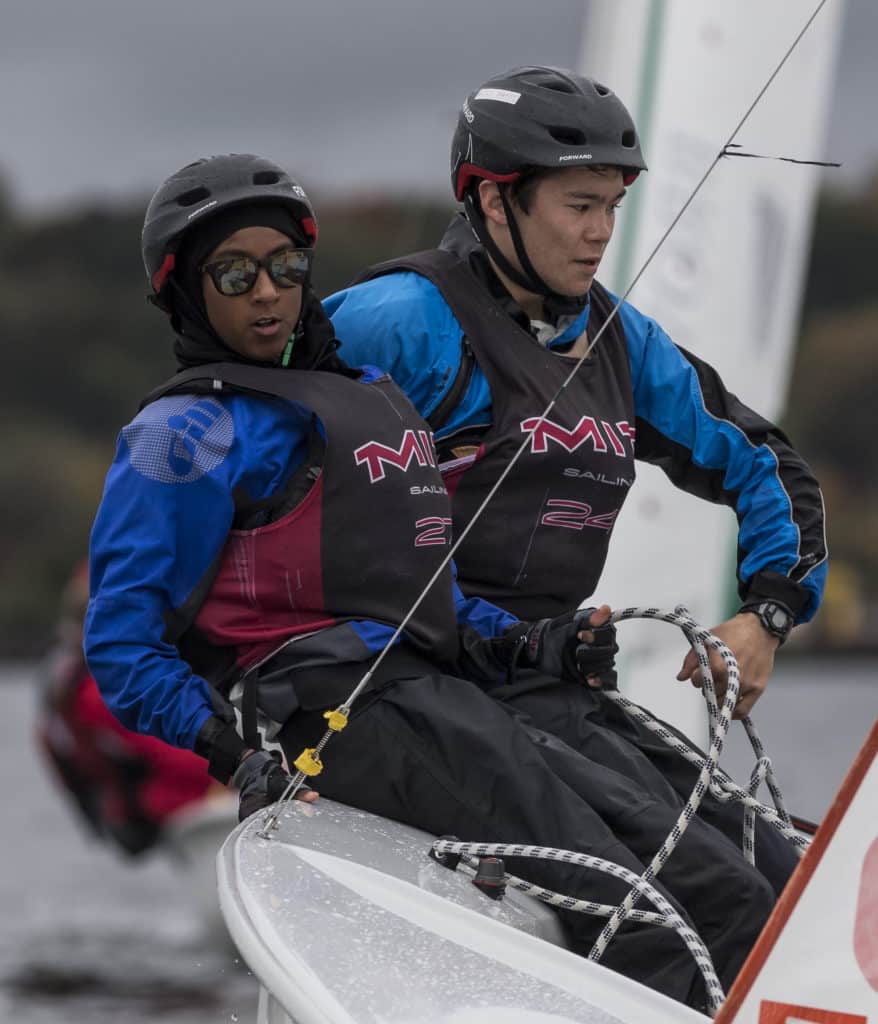
Could a helmet actually prevent a concussion if the wearer were hit by the boom? The jury is still out on that. Steve Murray, who owns Murray’s Sports, a major distributor of several brands of helmets specifically designed for sailors, as well as helmets for other watersports, is convinced they can at least reduce the possibility. With a helmet, says Murray, “it’s much more likely to be a glancing blow for two reasons. First, the neck is not going to hold the helmet in position. Second, because the helmet is round, it’s going to do its best not to block a strike but to parry it. It’s going to move out of the way, so a hard blow becomes a glancing blow.”
Helmets are now being specifically marketed for sailing, and we decided to take a look at a sampling. Murray says there are no U.S. standards for watersports helmets. All of the ones we looked at, however, were EN 1385 certified, meaning they passed European standards. European standards include a clear field of vision, covering necessary parts of the head, shock-absorption capacity, retention system (chin-strap webbing) performance, buoyancy and durability.
The helmets featured one of two types of padding: polystyrene foam, such as what you’ll find in most cycling, skateboarding and skiing helmets, and closed-cell foam. The polystyrene helmets were thicker, creating a larger profile. They were also much more rigid. With the exception of the Magic Marine Impact Pro, the closed-cell foam helmets were thinner and much more flexible. The polystyrene helmets also tended to be a bit heavier, although by an amount small enough to make the difference almost negligible.
What are some considerations when choosing a helmet? The biggest is adjustability for fit. No matter how well the helmet is built, if it doesn’t fit well, it’s game over. Not only will it be uncomfortable, but you’ll compromise the helmet’s protective capability. In fact, it can even become dangerous. A test aboard a Moth involved a high-speed ejection, and because of a poor fit, the helmet ended up off the back of the tester’s head, with the strap around the tester’s neck.
Then there’s the choice of padding—polystyrene or closed cell. According to Murray, a polystyrene padded helmet will take a bigger impact, but like a biking helmet, it’s a “one-hit” helmet—after a significant strike, it should be replaced. On the plus side, they usually include adjustable headbands, which makes them easy to fit. They’re great for multiple users. Closed-cell foam helmets, on the other hand, can be used over and over, and because the foam is thinner than polystyrene, the helmet is usually closer fitting and less likely to snag on rigging, etc. They do require some custom fitting.
Other considerations are a matter personal preference and situation. Sail for long periods of time? Go for a lighter weight helmet. Low boom? A lower-profile helmet will likely result in fewer “head taps.” And if sun glare is an issue, look for a helmet with a visor, or bring along a regular visor to wear inside the helmet when trying one out.
The Gear:
Forward Pro Wip The Pro Wip is a top-of-the-line helmet from Forward Sailing. The Dial-a-Fit system allows you to create a snug fit by turning a small ratcheting knob at the back of the helmet, identical to what you’ll find on many ski helmets. This model includes a second set of slightly thicker top and side pads, although neither the dealer nor we could figure out how to switch out the side pads. Still, with the adjustment knob, we were able to get a good fit, and after a short time sailing, we forgot we were even wearing the helmet.
Padding: polystyrene. 300 grams. Available in black/red, white/carbon or gray/cyan. $119.99 www.forward-wip.com
Forward Wipper
We tested a model with the optional earpieces and found it was a little tougher to hear — no surprise there. That’s OK if you’re by yourself, but if you’re trying to communicate with a crew, it might be an issue. There is no option of adding padding for a better fit, but a Velcro band across the back provides an inexpensive way to duplicate the Dial-a-Fit system found on the Pro Wip model. The built-in visor helps somewhat with sun glare, but it’s small enough that it doesn’t make a major difference.
Padding: closed-cell foam. 390 grams. Available in white, black, blue or yellow/black, with integrated earpiece. $64.95 www.forward-wip.com
Forward Wipper Kid’s Sailing Helmet
This is the little brother to the Forward Pro Wip, with many of the same features, including the thicker liner, narrow visor and Dial-a-Fit system. The Forward Wipper kid’s helmet is made for a small head, for kids 10 years of age or younger.
Padding: closed-cell foam. 390 grams. Available in orange or white/red. $49.95 www.forward-wip.com
This Australian-made helmet was a bit like a second skin. It fit more closely than any other helmet right out of the box, with the exception of those equipped with Dial-a-Fit. It also had the lowest overall profile and the lightest weight of any of the helmets we looked at. The product includes three reusable, self-adhering fit strips, about an inch in width, that allow you to customize the fit around the circumference of your head. Small detail: We liked the buckle placement, not under the chin but well off to one side, which prevented chin chafe — nice touch. The helmet comes with optional earpieces and a visor.
Padding: closed-cell foam. 272 grams. Available in white, matte black, carbon finish, Kryptic, iridescent blue, red, platinum silver, orange or yellow. $149
Buy It Now
This model comes from Predator Designs, a company that designs helmets for everything from motorcycles and skateboards to watersports, so it’s no surprise that the Impact Pro is similar to a ski or skateboarding helmet. With almost double the thickness of foam padding found in other helmets, the Impact Pro looks like it could take a wallop. The trade-off is that this is also the heaviest helmet of the group. The sun bill is just long enough to reduce glare between the helmet and the top of your sunglasses, yet easily allows looking up without tilting your head back, as you must with a baseball cap. There are two thickness options for the skull pads to customize the fit, and a mechanical rear-adjuster knob, similar to Forward’s Dial-a-Fit.
Padding: closed-cell foam. 440 grams. Available in navy only. $80.
Buy It Now
A thin-profile helmet, the H1 has a half-inch foam lining and two thickness options for skull pads to optimize fit. Getting the right combination of foam interior strips to allow the helmet to fit snugly without being too tight took a bit of experimenting. We ended up with a combination of thin and thick pads in different places. Molded internal channels allow for good airflow, keeping your head cool even on hot days. A foam pad fits over the chin strap to prevent chafing, but because of the central buckle location, the strap fit only off to one side rather than directly below the chin, where it would do the most good. The H1 runs a bit large — if you normally wear a large, a medium will likely be your best bet.
Padding: closed-cell foam. 378 grams. Available in black only. $119.
Buy It Now
Our favorites? We kept coming back to the Zhik H1, but preferred to wear it with an old Sailing World visor to cut down on glare between the top of our sunglasses and the helmet. The Gath Surf Convertible was also at the top of our list—nice fit with a low profile, although we’d forego the ear pieces, as the wind flow passing between those and our ears increased the sound level.
The best way to find the right helmet for you is to try some on. And even then, it’s likely the helmet will need to be customized — a little more padding here, a little less there. We found that a number of helmets fit well in one direction, such as front to back, but were too loose side to side. And while we liked the idea of a low-profile helmet, the difference between those and the high-profile helmets is small enough that it takes only a little sailing to get used to the extra thickness.


